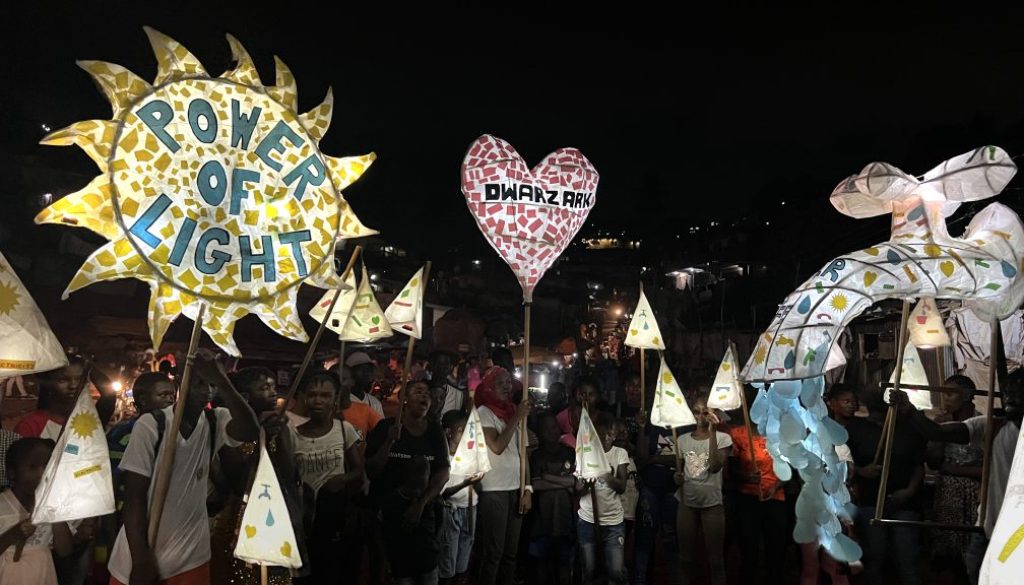IMPACT STORY: How ARISE art projects facilitated community priority setting and communication in Freetown informal settlements
Authors: Sia Tengbe, Kate Hawkins, Ibrahim Juldeh Sesay, Samira Sesay, Ibrahim Gandi, Sulliman Conteh, Abu Conteh, Samuel Saidu, Francis Reffell, Briama Koroma, Joseph Macarthy, Bintu Mansaray
ARISE research has taken an interdisciplinary approach to data collection within the broad remit of Community-Based Participatory Research (CBPR). One area of collaboration that has been particularly fruitful is partnership and engagement with artists and the arts. This has constituted a fascinating innovation in the way data is collected and communicated on health and wellbeing in informal settlements. An opportunity to receive Liverpool City Council financial support to partner with internationally recognised artist Luke Jerram was taken up by partners in Sierra Leone. Dubbed the ‘Power of Light’ project, this partnership was an opportunity to make an impact on the communities that we work with in Freetown.
Background
Since 2020, the Sierra Leone team – from the Centre of Dialogue on Human Settlement and Poverty Alleviation (CODOHSAPA), the College of Medicine and Allied Health Sciences (COMAHS), the Institute of Gender and Children’s Health Research (IGCHR) and the Sierra Leone Urban Research Centre (SLURC) – have been collecting data relating to health, wellbeing, health systems accountability, spatial inequalities and other forms of marginality using a range of participatory methods in informal settlements in Freetown. These findings have been documented in blogs, articles, briefs and dissemination workshops. However, effectively communicating these findings at the community level has been a challenge.
A range of concerns have been highlighted through this work and even though there are other factors at play a lack of safety and security, especially at night, and particularly for women and girls was one of these concerns. The risk of harm reported by women and girls is related to inadequate water, sanitation and hygiene facilities, since responsibilities for cleaning and the collection of water are often gendered, with women and girls assumed to be responsible. Study communities also were concerned about the impact of inadequate and unreliable electricity supply on their daily activities such as their livelihoods and their children’s education.
The Power of light project presented an opportunity to help address these issues. The Power of Light project was funded by the Liverpool City Council and Luke Jerram (a UK-based artist of international renown) as part of the 125th anniversary celebration of Liverpool School of Tropical Medicine.
Luke and a videographer, Jackson Kingsley, travelled to Freetown and worked with ten local artists who had been identified by the research team. They all collaborated on the ‘Power of Light’ Project. The Project was a combination of the creation of paper-based light sculptures, the installation of solar powered street lighting and a street carnival.
The artists were introduced to the key messages from the ARISE research related to safety, education, access to water and sanitation services and climate change. Twenty one solar-powered streetlights were installed in public areas across three communities. A parade at Dwarzark which brought together school children, community chiefs, youth, researchers and co-researchers marked the end of the project in Freetown where the installed solar lights were officially switched on and handed over to the community. Participants danced to melodious tunes played by a local brass band through the main street from Dwarzark Junction to the community centre near the main football field, showcasing designed sculptures to the community. The evening ended with refreshments and the distribution of 60 small LED lights to participating children to help with homework and navigating more safely at night. Furthermore, the team also rehabilitated the Moyiba community primary school, and the main water point in Cockle Bay. The project was documented in a short film. The impact of this work has reverberated outwards. In 2023 a presentation on this work won best innovative poster award at the International Conference on Urban Health.
Impact
The inclusion of locally based artists and a film maker in the co-production process was an opportunity for capacity building, cross learning and fostering stronger relationships in the community.The paper sculptures reflected the identified health and wellbeing priorities of residents within our communities and reflected these messages back to the broader community in a fun, inclusive and simple manner.
The distribution of LED lights to children and the rehabilitation of the primary school helped to provide a supportive learning environment and highlighted the importance of education for children. The rehabilitation of Moyiba primary school can help create a more conducive learning environment and may potentially improve their academic performance and educational outcomes. The rehabilitation of the main water point at Cockle Bay and toilet facilities at the Moyiba primary school will improve access to water, sanitation and hygiene facilities.
The installation of solar powered streetlights has helped to address some of the safety concerns that disproportionally affect women and children at night within these communities. They have also had the knock-on effect of supporting local businesses who can now stay open later.
Lessons learned
The installation of the streetlights was widely accepted and appreciated by residents of the three communities as they saw the increased economic, educational, and security potential of the project. However, due to the limited number of lights that were installed, not all areas in the communities were sufficiently covered. Issues of equity are a core concern for ARISE and this learning was fed back into subsequent art projects. The Power of Light project acted as a catalyst for other ARISE countries to conceive of and implement their own art projects, including photography in India and Kenya, the recording of the songs of waste workers in India and other artistic collaborations with Luke in Nepal and Bangladesh.
